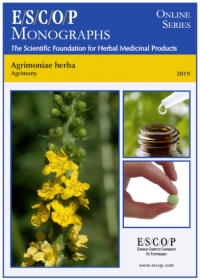Agrimoniae herba
Agrimony
Agrimonia eupatoria L.
Published 2019
Format: PDF

ESCOP monographs The Scientific Foundation for Herbal Medicinal Products. Online series. Agrimoniae herba (Agrimony). Exeter: ESCOP; 2019.
Agrimoniae herba (Agrimony)
>> Ver online (¤30 por año, gratis para los miembros de las sociedades integradas en ESCOP, como SEFIT)
>> Descargar monografía (15¤ para el público en general, 12¤ para los socios de SEFIT
SUMMARY
The herbal monograph selects and summarizes scientific studies and textbooks regarding efficacy, dosage and safety to support the therapeutic uses of agrimony.
This herbal drug by definition consists of the dried flowering tops of Agrimonia eupatoria L. Studies with its main characteristic constituents tannins, proanthocyanidins, ellagitannins and flavonoids are included.
The therapeutic indications are mild diarrhoea, as a gargle for inflammation of the oral and pharyngeal mucosa and for wound healing as compresses or for irrigation.
Administration of agrimony addresses posology; its duration of use; contra-indications; special warnings; special precautions for use; interactions with other medicinal products; other forms of interaction; in pregnancy and lactation; its effects on ability to drive; undesirable effects; overdose.
In vitro experiments with agrimony showed anti-inflammatory effects. In vivo experiments with agrimony or its extracts in animals demonstrated anti-inflammatory, antidiabetic and antioxidant properties. Pharmacological studies in humans concerned its antioxidant activity.
Controlled clinical studies with agrimony demonstrated its use in reducing serum iron levels and urinary porphyrins in patients with cutaneous porphyria. Preclinical safety data were assessed in toxicity studies.
Safety data were assessed in human studies.
The selection of literature cited in the monograph is aimed at bringing together relevant information about the possible physiological roles of agrimony and its major constituents.
KEYWORDS
- Agrimoniae herba
- Agrimony
- Agrimonia eupatoria L.
- Diarrhoea, mild
- Inflammation of the oral and pharyngeal mucosa
- Wound healing



